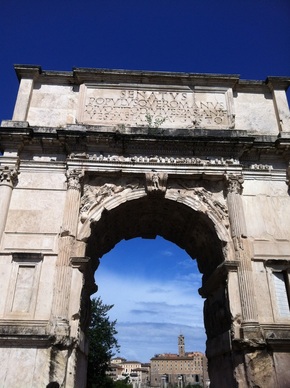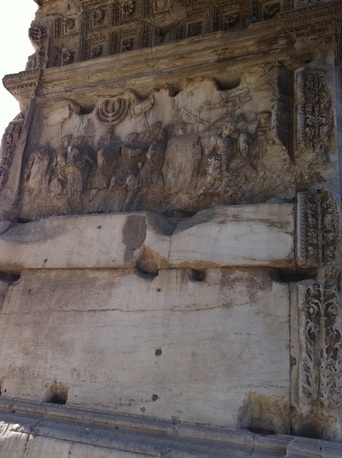 The Arch of Titus in Rome
The Arch of Titus in Rome The main information on this period comes from ancient reports, mainly the one of Josephus the priest (37-100ad), a Jewish general captured by Vespasian in 68ad who wrote ‘the Jewish war’.
In May 66ad the roman governor in Judea - Gessius Florius- sent his troops to Jerusalem’s upper market with instructions to kill everyone. The deaths were 3600: men, women and children.
The governor demanded the Jews to demonstrate their submission by greeting 2 cohorts entering Jerusalem, as the Jews rebelled the consequence was terrible.
At that time in Jerusalem there was a moderate party of the Jews led by Agrippa II (27-93ad), great grandson of Herod the great (73-4bc) appointed by the Romans. They attempted to cease the protest with no luck.
The Jews were divided into the war party and the peace party.
The priest Eleazar, captain of the temple, forbidden sacrifice paid by strangers thus impeding the longstanding custom of demonstrating loyalty by making offers to the temple on behalf of the emperor and Rome.
According to Josephus, our main source of information, 'this action laid the foundation of the war with Rome'.
 Detail of Titus' arch decoration showing the triuphal procession held in Rome after his victory.
Detail of Titus' arch decoration showing the triuphal procession held in Rome after his victory. A roman cohort of 600 men tried to help but was overcome. They surrendered in exchange of a possibility to exit the city safely, but when they laid down the weapons were attached and massacred.
Soon after, the governor of Syria, Cestius Gallus, arrived with a large army, and burned villages around Jerusalem to declare his intentions.
The rebels attacked him with success. When Cestius sent emissaries to negotiate peace those were killed or wounded.
Cestius moved to Jerusalem. He entered Jerusalem in order to besiege the inner city and the temple.
While he was about to enter the temple surprisingly he stopped and retired from the city.
When Cestius was marching toward the coast the army was attacked by the rebels: 5300 infantry and 480 cavalry were killed, the heavy artillery they were carrying was lost too.
This was not acceptable for the roman empire that wanted revenge.
The moderate Jews left the city while the others organized the city defense and generals, like Joseph, were given the task of patrolling the surrounding region.
The emperor Nero entrusted Titus Flavius Vespasianus to command the war.
Vespasian spent months collecting a huge force of 60000 men. In the first 2 years (66-68ad) he gained control of the countryside.
While he was ready to siege Jerusalem he was distracted by his personal ambitions caused by the events following the death of Nero.
In 69 Vespasian was elected emperor by his army.
The Jews rebellion lasted 5 years. The revolutionary government proclaimed a self conscious new state giving it the new name of Israel.
Evidence of this proud and independent state was the coinage of new coins during the revolt.
This state was indeed affected by faction struggles. The city was divided by competing factions and shifting alliances. Murders and appropriations of wealth was done by the insurgents and the zealots.
There were three generals and three army in Jerusalem: the outer and larger circuit of walls was held by Simon; the middle of the city by John, and the temple was guarded by Elazar. They were constantly fighting against each other and finally John got possession of the temple.
In 70ad the political divisions ended when Titus arrived to siege the city.
Titus got a with a larger army made of four legions, plus contingents of allied kings and Syrian auxiliaries. Titus acted with great speed and vigor and the Jews didn’t expected.
Jerusalem was particularly crowded then as families from the surrounding villages had gone to the temple to celebrate the Passover festival.
They all remained blocked inside the city.
Titus built a circuit of walls around the city to impede the escape and to cut the food supplies. He starved the population.
Joseph accounts of the famine is horrible.
Titus was hoping to induce the Jews to surrender. At the same time rather than just waiting for them to starve he assaulted the northwest wall of the city.
After 15 days of assault with heavy artillery, catapults, ballista balls and siege towers they entered the wall and the Jews retreated behind a second fortification line that was overcome 5 days after.
With this demonstration of power Titus was sure the Jews would have surrendered. He forbade his troops to kill and set fire and gave an opportunity to the revolutionary to vacate the city.
He wished to preserve the city and the temple but the Jews rejected the terms and counter attacked.
Other 4 days were needed to react and regain the inner wall.
The same Josephus prayed his citizens to surrender without success.
The assault to gain the central part of the city was under way, when the Jews were able to set fire on the 4 siege towers of the Romans. Even if there was shortage of timber in the region after 3 week new wooden rampant were ready.
The attack was brave and the resistance strong. Josephus recounts that ‘after Titus saw his endeavor to spare a foreign temple led only to the injury of his troops decided to set the gates on fire’.
The final assault to the inner sanctuary was a massacre.
The 9th July 70ad was the anniversary of the destruction of the temple by the Babylonians in 586bc and the roman forces managed to extinguish a fire to have access to the inner sanctuary, the resistance of the insurgents was stout, but thanks to the cavalry the roman succeded.
The following day Titus assaulted the inner sanctuary with his whole troops and slaughtered all who were caught.
The capitulation of the rest of Jerusalem was rapid.
The roman soldiers were given way to kill and loot until Titus decided the city to be razed to the ground.



